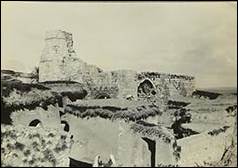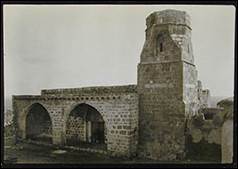Grande Mosquée de Yavne (676/1277)
Localisation : à l’est de la ville, sur le tell Yavne.
Réf :
Clermont-Ganneau (1896), II, p.168-173 ; 176-177
Conder/Kitchener (1881), II, p.441-442
Mayer/Pinkerfeld (1950), p.24
Meinecke (1992), 4/263, 9C/370
RCEA 5723
Historique
L’ancienne église Croisée[1] est organisée en mosquée par le sultan Baybars (r.17 dhu’l-qa’da 658/24.X.1260 – 27 muharram 676/30.VI.1277). Un minaret est ajouté le 1 rabi’ II 738/27.X.1337 par l’émir Bashtâk al-Nâsirî, sous le 3e règne du sultan al-Nâsir Muhammad (r.30 ramadan 709/3.III.1310 – 21 dhu’l-hijja 741/7.VI.1341).
L’édifice est décrit comme étant en ruines par Clermont Ganneau en 1870 et 1873 ; il en fait un dessin (voir plus bas)[2] et par Conder et Kitchener en 1875.[3] Aujourd’hui il ne reste que le minaret avec son inscription de costruction qui s’élève sur le tell (ill.1, 4-6).
Epigraphie
738/1337. Texte de construction 4 lignes sur le minaret (ill.11).[4]
« xxx la construction de
cette tour d’appel bénie a été ordonnée par Sa haute Grandeur notre maître le
grand émir Saif al-Dîn Bashtâk al-Nâsirî, le 1er rabi’II de l’année
738 (27.X.1337) ».
Biblio complémentaire
Pringle (1998), n°280
Petersen (2001), n°159
Fischer/Taxel (2007), p.204-284
|
|
|
|
|
|
1/ plan et élévation de la mosquée |
2/ vue du minaret depuis le sud |
3/ façade sud du minaret |
4/ accès au minaret et vestiges du mur de la salle
de prière |
|
|
|
|
|
|
5/ l’escalier du minaret |
6/ vestiges du mur de la mosquée |
7/ façade est du minaret |
8/ le minaret depuis le nord-est |
|
|
|
|
|
9/ façade nord du minaret |
10/ l’inscription sur la façade nord |
11/ l’inscription de construction datée 738/1337 |
Documents anciens
Clermont-Ganneau (1896), II, p.168-173 ; 176-177. Visite en 1870 et 1973.
Medieval Church. - Beyond the wely,
which I shall shortly have occasion to speak of again at greater length, there is
in the village itself a mosque (jame’), which is part of an old Crusaders'
church, and is very interesting. I had made a hurried sketch and plan of it already
in 1870 but this time we made a detailed and leisurely survey. There is really nothing
left of it now but the north-west corner, which the Arabs have arranged as a mosque,
at the expense of some disfigurement. The rest of the original nave has utterly
disappeared, razed to its foundations. These foundations might perhaps be discovered
in the adjoining houses. This demolition had an extremely practical end in view,
and I shall presently show why and when it was effected.
But first of all, here is a plan of the building in its present state, with a section from E to F. This section is at right angles to the east and west axis of the church, and passes through the northern aisle and the nave.
The Arabs, it will be noticed, have
built firstly a south wall, blocking up three bays in the south arcade of the
nave, and secondly an eastern wall, at right angles with the foregoing, blocking
up a transversal bay of the nave and a transversal bay of the north aisle. Three
of the four pillars that are built into these walls can still be traced inside.
Two others remain, isolated in the middle of the present nave, and supporting six
groined vaults. Two of the primitive windows of the church still exist in the original
north wall, to the right and left of the modern door. This latter is pointed, and
was probably built by the Arabs, perhaps rebuilt not from their own materials.
Next follows the inside elevation
of one of the windows, which is splayed.
It is marked B on the general plan.
The level of the floor inside the
mosque is appreciably higher than the primitive level of the church, so that the
bases of the pillars are hid from view. In the north-west corner a staircase (A),
consisting of three flights at right angles, affords access to a minaret with a
large square base, which projects outwards, and seems to correspond, in its lower
part at any rate, to an old belfry of the church. The steps are formed of fine stones
carefully set, and were probably built by the Crusaders.
The plan next following, taken at
the level of the terrace of the mosque, shows the exterior configuration of the
staircase and the minaret to which it As one loolcs at the mosque on its north face
from the outside, it appears
as below (voir plus bas).
In the above engraving are visible
: - the Arab door ; to the right, the base of the minaret essentially mediaeval
in outline, with an ill-built Arab wall leaning against the right of it.
There has been subsequently built
into the north side of the base of the minaret an Arabic inscription. The rectangular
border enclosing it can be seen in the engraving. A translation of it will be found
in the Memoirs. It states that the minaret was erected in the year 738 (1337 A.D).
On penetrating into the courtyards and rooms of the Arab houses clustering round the mosque, we discovered on the outer west side the primitive door of the church, which the Arabs have blocked up with rubble. This is a perfect gem of Gothic architecture. The curve of arch is so slightly broken that at first glance it looks almost a semicircle.
This door is composed of one archivolt
and a series of recessing members. The details of these will be better understood
from the accompanying section than from a long description.
These arches rest on a simple
abacus supported by pillars without capitals. The bases of the latter are hidden
under the soil.
I should like to draw special
attention to the idea of the ornamentation of the large arch. It is grooved with
canaliculi, presenting the appearance of tiny archstones or rather small tablets
with their edges only showing, radiating from the same centres as those of the arch.
This idea seems to have been a favourite one in the architecture of the
Crusaders, and is found, among other places, in the arches of the doors of the Church
of the Holy Sepulchre and the Church of St. Anne at Jerusalem.
To complete our study of these details,
I give two sections showing the outline of the string-courses running inside and
outside along the walls at the same elevation as the abaci.
Our investigations among the Arab
houses took us to the outer south wall of the mosque. This is of Arab construction,
and forms a right angle with the primitive western wall, which has been destroyed
from a point a few yards from the axis of the mediaeval door. In this wall we discovered
a large pointed bay facing south, and now walled up (at F on the plan).
This bay, which has been blocked up
afterwards by the Arabs, I think, consists of an arch supported by two pillars with
moulded abaci, formed of a group of engaged pilasters. We were even able to distinguish
the base of the pillar G, which furnishes an important feature in the architectural
scheme, and determines the original level of the church. This bay belongs to the
first transversal bay of the church, and separates the nave from the southern aisle.
It is now easy to form a general
idea of the plan of the church, and by estimating its whole extent to make out what
parts have been destroyed. The axis of the church, which is orientated nearly from
east to west, passed through
the middle of the western door (P)
; to the left of this door there stood the belfry, forming a projection on the
north-western corner of the church. The north wall of the mosque is the northern
boundary wall of the church. This
wall was continued towards the east,
comprising one or perhaps two transverse bays, as far as the beginning of the apses,
of which there are now no signs to be seen above the surface of the ground. If we
start from the middle of the door P, which marks the central axis of the
church, and draw a line to the south equal in length to the distance from the middle
of the door to the north wall, it brings us to the dotted line indicating the boundary
of the row of
houses abutting on the mosque. The
walls of these houses must be built over the foundations of the south boundary wall
of the church, and have had probably their alignment determined by these foundations.
We thus obtain
the total breadth of the building,
which must have been about thirteen yards. The length must have been proportionate.
It becomes evident therefore that the whole of the south aisle has been destroyed,
and also the transverse bay,
forming a transept, the whole width of the three aisles, not to mention the apses, which have totally disappeared.
The Church. – ‘The outer facing of the walls is much worn away; there are shafts of columns built in the walls through the whole thickness … The window has a charming profile ; it has a median joint (vertical) and the diagonal striae (mediaeval toolmarks) on the voussoirs The minaret has a square base, and the body of it is octagonal, after the style of the Egyptian minarets of the thirteenth—fifteenth centuries. It appears to be partly constructed of mediteval materials ; on some of the largest stones traces of diagonal striee are still visible. On the north front of the minaret, at about 13 feet from the ground, is a limestone slab about 0"" 70 long by 0"" 50 high, built into the wall, with an Arabic inscription in neskhy Mameluke characters, of average size and pleasing style, but rather indistinct :
"
In the name of the merciful and piritul God. Ordered the building of this blessed
minaret, bis exalted and lordly Eminence the great Emir Saif (ed-din) Bashtak, belonging
to (Sultan) En-Nasir, at the beginning of the month Rabi' II, in the year seven
hundred and thirty-eight"
The person spoken of is evidently the Emir Saif ed-din Bashtak en Nasiry, who played a part in politics under Sultan Mohammed En Nasir and built a mosque at Cairo, which has now disappeared, and a great palace of which some traces remain, which was terminated this same year, 738 . . . ."
|
|
|
|
|
|
Plan et élévation
de la Grande Mosquée Source: Clermont-Ganneau (1896), II |
Plan et dessin de la Grande Mosquée Source : Clermont-Ganneau (1896), II |
Vue de la mosquée depuis le sud d’après K.A.C.
Creswell au début du 20e siècle Source : archnet.org/collections/1255 |
Vue de la mosquée depuis le nord d’après K.A.C.
Creswell au début du 20e siècle Source : archnet.org/collections/1255 |














